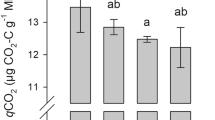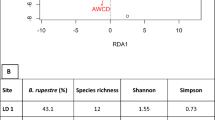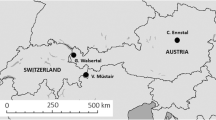Abstract
The present study investigated the effects of land-use abandonment on the soil decomposer community of two grazed Mediterranean ecosystems (an annual grassland with scattered holm oaks and a low-density shrubland). To test the influence of grazing abandonment, a set of plots within each site were fenced and kept undisturbed during 4–5 years, during which above-ground plant community structure was monitored. After that, soil samples were collected from grazed and abandoned plots corresponding to the three different soil conditions: away from (“grass”) and below tree canopies (“oak”) within the annual grassland, and from the shrubland (“shrub”). Soil samples were split into two different layers (0–5 and 5–15 cm) and then analyzed for saprotrophic fungal (acetate into ergosterol incorporation) and bacterial (leucine incorporation) growth rates. Ergosterol content (as a fungal biomass estimator) and a standard set of soil chemistry variables were also measured. After 5 years of grazing exclusion, saprotrophic fungal growth rate clearly increased in both grass and oak surface layers whereas bacterial growth rate was not altered. This translated into significantly higher fungal-to-bacterial (F/B) growth rate ratios within the ungrazed plots. Similar trends were observed for the shrub soils after 4 years of exclusion. On the contrary, abandonment of grazing had negligible effects on the ergosterol content, as well as on the soil chemical variables (soil organic carbon, total N, C/N ratio, and pH), in all the three soil conditions assessed. These results indicated a shift toward a more fungal-dominated decomposer activity in soils following cessation of grazing and highlighted the sensitivity of the microbial growth rate parameters to changes associated with land use. Moreover, there were evidences of a faster fungal biomass turnover in the ungrazed plots, which would reflect an accelerated, though not bigger, fungal channel in soil organic matter mineralization.



Similar content being viewed by others
References
Anderson JP, Domsch KH (1973) Quantification of bacterial and fungal contributions to soils respiration. Arch Microbiol 93:113–127
Bailey VL, Smith JL, Bolton H Jr (2002) Fungal-to-bacterial ratios in soils investigated for enhanced C sequestration. Soil Biol Biochem 34:997–1007
Barcenas-Moreno G, Gomez-Brandon M, Rousk J, Bååth E (2009) Adaptation of soil microbial communities to temperature: comparison of fungi and bacteria in a laboratory experiment. Glob Change Biol 15:2950–2957
Bardgett RD, Frankland JC, Whittaker JB (1993) The effects of agricultural practices on the soil biota of some upland grasslands. Agric Ecosyst Environ 45:25–45
Bardgett RD, Hobbs PJ, Frostegård Å (1996) Changes in soil fungal:bacterial biomass ratios following reductions in the intensity of management of an upland grassland. Biol Fertil Soils 22:261–264
Bardgett RD, Wardle DA, Yeates GW (1998) Linking above-ground and below-ground food webs: how plant responses to foliar herbivory influence soil organisms. Soil Biol Biochem 30:1867–1878
Bardgett RD, McAlister E (1999) The measurements of soil fungal: bacterial biomass ratios as an indicator of ecosystem self-regulation in temperate meadow grasslands. Biol Fertil Soils 29:282–290
Bittman S, Forge TA, Kowalenko CG (2005) Responses of the bacterial and fungal biomass in a grassland soil to multi-year applications of dairy manure slurry and fertilizer. Soil Biol Biochem 37:613–623
Busse MD, Sánchez FG, Ratcliff AW, Butnor JR, Carter EA, Powers RF (2009) Soil carbon sequestration and changes in fungal and bacterial biomass following incorporation of forest residues. Soil Biol Biochem 41:220–227
Bååth E (1994) Measurement of protein synthesis by soil bacterial assemblages with the leucine incorporation technique. Biol Fertil Soils 17:147–153
Bååth E (2001) Estimation of fungal growth rates in soil using 14C-acetate incorporation into ergosterol. Soil Biol Biochem 33:2011–2018
Bååth E, Pettersson M, Soderberg KH (2001) Adaptation of a rapid and economical microcentrifugation method to measure thymidine and leucine incorporation by soil bacteria. Soil Biol Biochem 33:1571–1574
Carney KM, Hungate BA, Drake BG, Megonigal JP (2007) Altered soil microbial community at elevated CO2 leads to loss of soil carbon. PNAS 104:4990–4995
Casals P, Gimeno C, Carrara A, Lopez-Sangil L, Sanz MJ (2009) Soil CO2 efflux and extractable organic carbon fractions under simulated precipitation events in a Mediterranean Dehesa. Soil Biol Biochem 41:1915–1922
Christensen S, Bjornlund L, Vestergård M (2007) Decomposer biomass in the rhizosphere to assess rhizodeposition. Oikos 116:65–74
Denef K, Six J, Bossuyt H, Frey SD, Elliott ET, Merckx R, Paustian K (2001) Influence of dry–wet cycles on the interrelationship between aggregate, particulate organic matter, and microbial community dynamics. Soil Biol Biochem 33:1599–1611
De Boer W, Folman LB, Summerbell RC, Boddy L (2005) Living in a fungal world: impact of fungi on soil bacterial niche development. FEMS Microbiol Rev 29:795–811
De Vries FT, Hoffland E, van Eekeren N, Brussaard L, Bloem J (2006) Fungal/bacterial ratios in grasslands with contrasting nitrogen management. Soil Biol Biochem 38:2092–2103
De Vries FT, Bloem J, van Eekeren N, Brusaard L, Hoffland E (2007) Fungal biomass in pastures increases with age and reduced N input. Soil Biol Biochem 39:1620–1630
Duguy B, Rovira P, Vallejo R (2007) Land-use history and fire effects on soil fertility in eastern Spain. Eur J Soil Sci 58:83–91
FAO (2006) World Reference Base for soil resources. A framework for international classification, correlation and communication. FAO, Rome, ISSN 0532-0488
Gaspar P, Escribano M, Mesías FJ, Rodriguez de Ledesma A, Pulido F (2008) Sheep farms in the Spanish rangelands (dehesas): typologies according to livestock management and economic indicators. Small Rumin Res 74:52–63
Gaspar P, Mesías FJ, Escribano M, Pulido J (2009) Assessing the technical efficiency of extensive livestock farming systems in Extremadura, Spain. Livest Sci 121:7–14
Gordon H, Haygarth PM, Bardgett RD (2008) Drying and rewetting effects on soil microbial community composition and nutrient leaching. Soil Biol Biochem 40:302–311
Grayston SJ, Shenquiang W, Campbell CD, Edwards AC (1998) Selective influence of plant species on microbial diversity in the rhizosphere. Soil Biol Biochem 30:369–378
Guggenberger G, Frey SD, Six J, Paustian K, Elliott ET (1999) Bacterial and fungal cell wall residues in conventional and no-tillage agroecosystems. Soil Sci Soc Am J 63:1188–1198
Hemmat A, Adamchuk VI (2008) Sensor systems for measuring soil compaction: review and analysis. Comput Electron Agric 63:89–103
Jastrow JD, Amonette JE, Bailey VL (2007) Mechanisms controlling soil carbon turnover and their potential application for enhancing carbon sequestration. Clim Change 80:5–23
Joergensen RG, Wichern F (2008) Quantitative assessment of the fungal contribution to microbial tissue in soil. Soil Biol Biochem 40:2977–2991
Klumpp K, Fontaine S, Attard E, Le Roux X, Gleixner G, Soussana JF (2009) Grazing triggers soil carbon loss by altering plant roots and their control on soil microbial community. J Ecol 97:876–885
Macdonald CA, Thomas N, Robinson L, Tate KR, Ross DJ, Dando J, Singh BK (2009) Physiological, biochemical and molecular responses of the soil microbial community after afforestation of pastures with Pinus radiata. Soil Biol Biochem 41:1642–1651
Maharning AR, Mills AAS, Adl SM (2009) Soil community changes during secondary succession to naturalized grasslands. Appl Soil Ecol 41:137–147
Nylund JE, Wallander H (1992) Ergosterol analysis as a means of quantifying mycorrhizal biomass. In: Norris JR, Read DJ, Varma AK (eds) Methods in microbiology. Academic, London, pp 77–88
Paterson E, Osler G, Dawson LA, Gebbing T, Sim A, Ord B (2008) Labile and recalcitrant plant fractions are utilised by distinct microbial communities in soil: Independent of the presence of roots and mycorrhizal fungi. Soil Biol Biochem 40:1103–1113
Paterson E, Midwood AJ, Millard P (2009) Through the eye of the needle: a review of isotope approaches to quantify microbial processes mediating soil carbon balance. New Phytol 184:19–33
Pietikäinen J, Pettersson M, Bååth E (2005) Comparison of temperature effects on soil respiration and bacterial and fungal growth rates. FEMS Microbiol Ecol 52:49–58
Rousk J, Bååth E (2007a) Fungal biomass production and turnover in soil estimated using the acetate-in-ergosterol technique. Soil Biol Biochem 39:2173–2177
Rousk J, Bååth E (2007b) Fungal and bacterial growth in soil with plant materials of different C/N ratios. FEMS Microbiol Ecol 62:258–267
Rousk J, Demoling LA, Bahr A, Bååth E (2008) Examining the fungal and bacterial niche overlap using selective inhibitors in soil. FEMS Microbiol Ecol 63:350–358
Rousk J, Demoling LA, Bååth E (2009a) Contrasting short-term antibiotic effects on respiration and bacterial growth compromises the validity of the selective respiratory inhibition technique to distinguish fungi and bacteria. Microb Ecol 58:75–85
Rousk J, Brookes PC, Bååth E (2009b) Contrasting soil pH effects on fungal and bacterial growth suggests functional redundancy in carbon mineralization. Appl Environ Microbiol 75:1589–1596
Saetre P, Stark JM (2005) Microbial dynamics and carbon and nitrogen cycling following re-wetting of soils beneath two semi-arid plant species. Oecologia 142:247–260
Sakamoto K, Oba Y (1994) Effect of fungal to bacterial biomass ratio on the relationship between CO2 evolution and total soil microbial biomass. Biol Fertil Soils 17:39–44
Scheller E, Joergensen RG (2008) Decomposition of wheat straw differing in nitrogen content in soils under conventional and organic farming management. J Plant Nutr Soil Sci 171:886–892
Six J, Frey SD, Thiet RK, Batten KM (2006) Bacterial and fungal contributions to carbon sequestration in agroecosystems. Soil Sci Soc Am J 70:555–569
Soon YK, Abboud S (1991) A comparison of some methods for soil organic carbon determination. Commun Soil Sci Plant Anal 22:943–954
Söderström B, Read DJ (1987) Respiratory activity of intact and excised ectomyccorhizal mycelial systems growing in unsterilized soil. Soil Biol Biochem 19:231–236
Strickland MS, Rousk J (2010) Considering the fungal:bacterial dominance in soils: methods, controls and ecosystem implications. Soil Biol Biochem 42:1385–1395
Suberkropp K, Weyers H (1996) Application of fungal and bacterial production methodologies to decomposing leaves in streams. Appl Environ Microbiol 62:1610–1615
Thiet RK, Frey SD, Six J (2006) Do growth yield efficiencies differ between soil microbial communities differing in fungal:bacterial ratios? Reality check and methodological issues. Soil Biol Biochem 38:837–844
Wardle DA, Bardgett RD, Klironomos JN, Setälä H, van der Putten WH, Wall DH (2004) Ecological linkages between aboveground and belowground biota. Science 304:1629–1633
Wichern F, Mayer J, Joergensen RG, Müller T (2007) Release of C and N from roots of peas and oats and their availability to soil microorganisms. Soil Biol Biochem 39:2829–2839
Zeller V, Bardgett RD, Tappeiner U (2001) Site and management effects on soil microbial properties of subalpine meadows: a study of land abandonment along a north-south gradient in the European Alps. Soil Biol Biochem 33:639–649
Zornoza R, Guerrero C, Mataix-Solera J, Scow KM, Arcenegui V, Mataix-Beneyto J (2009) Changes in soil microbial community structure following the abandonment of agricultural terraces in mountainous areas of Eastern Spain. Appl Soil Ecol 42:315–323
Acknowledgments
We want to thank Paulo and CEAM researchers Arnaud Carrara and Cristina Gimeno for their help during field sampling. This work was partially supported by a COST STSM fellowship and funded by the Spanish Ministerio de Agricultura (INIA, Balangeis) and Ministerio de Educación y Ciencia (VULCA; GRACCIE research net). JR was supported by a Swedish Research Council (VR) postdoctoral fellowship.
Author information
Authors and Affiliations
Corresponding author
Rights and permissions
About this article
Cite this article
Lopez-Sangil, L., Rousk, J., Wallander, H. et al. Microbial growth rate measurements reveal that land-use abandonment promotes a fungal dominance of SOM decomposition in grazed Mediterranean ecosystems. Biol Fertil Soils 47, 129–138 (2011). https://doi.org/10.1007/s00374-010-0510-8
Received:
Revised:
Accepted:
Published:
Issue Date:
DOI: https://doi.org/10.1007/s00374-010-0510-8




